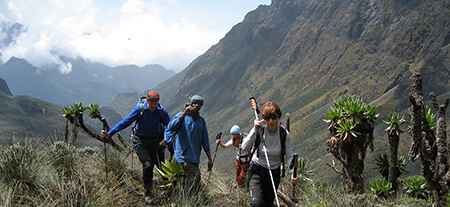Trekking in Uganda – Hiking for Leisure to Adventure and Enjoy Sceneries or Wildlife
 Trekking in Uganda means any form of climbing tourist activities done at the various hiking destinations in Uganda. Trekking as an outdoor activity means going on a arduous journey typically on foot in search of something or trying to find something or lead somewhere. Trekking is also an open activity of walking for more hours or than a day. It is a category of walking taken with a purpose of enjoying or exploring scenery or animals living in a given location. Trekking could be a motive, It could be a commitment, an aim, an objective, a mission, a party, a social gathering.
Trekking in Uganda means any form of climbing tourist activities done at the various hiking destinations in Uganda. Trekking as an outdoor activity means going on a arduous journey typically on foot in search of something or trying to find something or lead somewhere. Trekking is also an open activity of walking for more hours or than a day. It is a category of walking taken with a purpose of enjoying or exploring scenery or animals living in a given location. Trekking could be a motive, It could be a commitment, an aim, an objective, a mission, a party, a social gathering.
Trekking in Uganda Activities
Uganda has different activities that tourists enjoy as they explore nature and its treasures. These trekking activities in Uganda include primate trekking that comprises of gorilla trekking in Bwindi forest and Mgahinga Gorilla National Park and Chimpanzee trekking at various chimp tracking destinations plus golden monkey trekking at Mgahinga. Rhino trekking in Uganda at Ziwa Rhino Wildlife Ranch in Nakasongola district is another adventure activity one can enjoy in the Pearl of Africa while on a holiday tour. Mountain trekking is another adventure mainly done on Rwenzori Mountains National Park and Mount Elgon National Park. Kagulu Rock climbing in Busoga plus mountain climbing in Mgahinga including hiking Mount Sabyinyo, Gahinga and Muhabura are other adventure trekking excursions in Uganda. Gorilla trekking in Uganda dominates the major hiking activities following by chimpanzee tracking and Rwenzori climbing.
Hiking Destinations in Uganda
Hiking destinations in Uganda include Bwindi Impenetrable National park, Mgahinga Gorilla National Park, Rwenzori Mountains, Mount Elgon National Park. Others trekking areas include all the chimps trekking spots in Uganda like Kibale National Park, the biggest chimpanzee habitat in the country, Kalinzu Central Forest Reserve, Kyambura Gorge in Queen Elizabeth National Park and Toro-Semuliki Wildlife Reserve. In Murchison Falls National Park, there is a hiking activity that takes place from the bottom of the falls to the Top of the Falls, while are part of the magnificent River Nile that runs through the large park. Another interesting trekking destination is Mount Moroto, one of the tourist places in northern Uganda found specifically in Karamoroja sub region.
Types of Trekking:
Trekking as an adventure concept is mainly of four kinds and all the major activities mentioned above fall within the forms below.
- Easy Trekking: This type of activity is for beginners and essentially includes the view of colorful skylines or sight of fine-looking nature.
- Moderate Trekking: This trekking is more challenging than easy trekking and usually performed on medium to slightly higher elevations. People doing this type of trekking should be energetic and healthy.
- Strenuous Trekking: This type of trekking necessitates vigorous physical efforts and is ultimately done on high height areas. This category is appropriate only for those with some previous experiences of trekking.
- Difficult Trekking: This form of trekking takes place on steep slopes and generally experienced or professional trekkers do this type of hiking. This nature of walking needs high level of accuracy skill, determination and endurance by the trekker.
7 Expert Trekking Tips You Must Know
- Always Carry a Clothesline and Clips.
- Convert Your Shoes into Sandals — Carry Less Weight. …
- Wear a Sun Cap that has Flaps.
- Always Trek with Two Trekking Poles.
- Use Micro-Steps While Climbing Uphill.
- Use Beta-dine Solution to Purify Water.
- Do Not Wear Cotton Clothes on a Trek.
How do I prepare for trekking?
- Do exercise you enjoy.
- Mix up the terrain and weather condition.
- Fuel your body well.
- Remember to pace yourself.
- Consistency and persistence is key.
- Understand your trip grade.
- Consider using walking poles.
- Practice walking with your backpack.
What to Pack for Trekking? – 10 Essentials things:
When going for a trek, bring a backpack to carry your gear. Ensure that you pack the most essentials items that you need. Below are 10 safety items that you should always carry with you on every hike:-
- warm clothing,
- food and water,
- map or other navigation aid,
- sun protection,
- fire starter,
- first aid kit,
- headlamp,
- emergency shelter,
- communication device,
- knife
